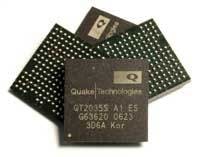Transceiver vendors have offered the SFP+ as an alternative to larger form factors, including the XFP; the American National Standards Institute’s T11 Group is currently working on a formal specification. The transceiver would contain a transmit optical subassembly, receive optical subassembly, laser driver, linear amplifier, and that’s about it. Clock data recovery (CDR), dispersion compensation, serializing/deserializing, bridging from XFI to XAUI interfaces, and related functions would be removed from the module and situated on the board-preferably in a single chip. The smaller, lower-power optical module would lead to reduced costs and increased port density over 10-GbE devices based on the XENPAK, X2, XPAK, and XFP form factors.
However, moving these functions onto the board carries its own challenges, not the least of which is conditioning the signal not only for possible transmission over at least 220 m of legacy multimode fiber (in the case of a 10GBase-LRM device) but over printed circuit board (PCB) traces as well. According to Mitch Kahn, who was Quake’s vice president of marketing at the time the chip was announced, signal conditioning must address distortion on both the transmit and receive sides of the equation. The QT2035S handles transmit requirements through “predistortion” of the TX signal. The distortion inherent in the PCB trace cancels the predistortion, meaning the signal arrives at the laser driver in a clean state. This function is firmware programmable to ensure the right amount of predistortion.
The chip uses EDC on the receive side. Kahn says Quake/AMCC is working with a combination of distributed feedback equalization and feed-forward equalization, as well as some homegrown mixed-signal intellectual property, resulting in a more robust device than the typical EDC chip.
Removing CDR and other functions from the module lowers the device’s cost and power consumption requirements. However, some have wondered whether a move to SFP+ would merely shift complexity and power consumption from the transceiver to the board. Kahn believes the new device addresses these concerns. The QT2035S supports all of the serial 10GBase standards for optical communications. It requires less than 950 mW typically, although that figure rises to less than 1.3 mW for LRM applications. It is housed in a 13×13-mm BGA package with both XAUI and XFI interfaces. Kahn described the price tag as “slightly higher” than that of a typical XFP PHY.
Kahn believes the device will enable the SFP+ form factor to dominate the enterprise and data center market. In fact, he says he urged Quake to pull its EDC device aimed at the XFP (the QT1006) off the market because of what he saw as limited future opportunity. While the subsequent acquisition by AMCC may change things, Kahn says he doubts that a standalone EDC device to replace the QT1006 is in the company’s future.
The signal conditioning properties of the QT2035S not only enable basic SFP+ operation, but open the door to the use of cheaper, lower-powered lasers than those commonly used for 10-Gbit/sec applications, Kahn adds. He envisions the use of 850-nm lasers, possibly similar to those found in 4-Gbit/sec Fibre Channel applications. Quake and transceiver vendor Picolight (www.picolight.com) demonstrated such a device this past March at OFC/NFOEC, with transmission over 1,300 m of multimode fiber with four splices.
The QT2035S began sampling to alpha customers last month; general sampling should begin this month, with production following in the first quarter of next year.